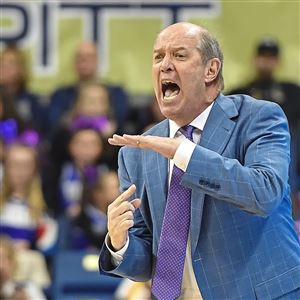The end of a season in any sport often brings closure. That’s not quite the case with the Pitt men’s basketball program.
A three-point loss Tuesday to Notre Dame in the first round of the ACC tournament ended the Panthers’ 2017-18 season, but from it come more questions and more uncertainty . Last season, they lost 10 players either to graduation, transfer or disciplinary dismissal. This season, while not as great in number, the changes could be even more far-reaching.
Below are some thoughts on what Pitt may face and how it got to this point:
1. The first and most unavoidable topic is Kevin Stallings’ job status. It’s rare for a coach to get fired before his third season, but many of the cases in which it happened are tenures that seemed star-crossed from the start.
Speculation over someone’s employment and livelihood is uncomfortable, but it exists for a reason. Stallings’ record in his time at Pitt has been poor, attendance is at its lowest point since 1982 and the ignominy of going 0-19 in conference play may be too much for anyone to overcome. Once your job security becomes a point of public chatter, recruiting talented players to turn that misfortune around becomes that much more difficult.
Add in the fact that Heather Lyke has twice been given a chance to give Stallings something resembling a public show of support — first in a statement to the Post-Gazette in January and in an interview late last month with 93.7 The Fan — only not to, and you wind up in the situation in which the program and its coach currently find themselves.
2. As Stallings’ time in Oakland is debated, it’s important to not overlook other factors that have led us here. Part of the looming uncertainty is due to this 8-24 season, sure, but anyone with a sense of college basketball history and the landscape of the sport knew this was going to be a difficult season, even a potentially winless-in-conference one. A program cannot start over with an entirely new roster — short of being Duke or Kentucky with six or seven top-50 recruits — and expect to be competitive.
Some of this goes back to last season. The 2016-17 Panthers were undeniably flawed, without a true point guard and the kind of depth that was lost with lesser-discussed departures like Sterling Smith and Rafael Maia, but a team with four senior starters, two of the ACC’s top scorers and someone who is now one of the best players for a top-15 North Carolina team went 4-14 in ACC play. It was, for Stallings, a damaging missed opportunity to engender some much-needed goodwill. Had that season not unfolded the way it did and were Scott Barnes still the school’s athletic director, it’s highly doubtful we’d be having the conversation we are.
3. Make no mistake about it — Stallings’ players love him. Following the loss Tuesday, many of them, particularly Terrell Brown and Shamiel Stevenson, offered full-throated defenses of Stallings when asked about his future.
“We all believe in Coach Stallings,” Brown said Tuesday. “He recruited all of us. He personally came to all of us. We were all freshmen. He came to us and we put our trust in him.”
Such words could be cynically seen as lip service, but from talking to players throughout the season about their recruitment and the togetherness of the team, it’s hard to see it as anything other than genuine.
4. That public support, though, can help contribute to a common fallacy: If a coaching change is made, all or most of the current players will flee and a team will be forced to rebuild. That’s hardly always the case. In many instances, the process is more gradual.
Last season, for example, Ohio State retained six of its top eight leading returning scorers despite replacing a beloved coach in Thad Matta. Duquesne brought back five of its top seven leading returning scorers after Keith Dambrot was hired to replace Jim Ferry. These changes in power don’t always work out in such ways, but they’re also seldom the doomsday scenarios some predict.
5. If Stallings is fired and such a roster reconstruction is possible, who are the players worth trying to keep? A couple of players — junior Jared Wilson-Frame and St. John’s transfer Malik Ellison — seem ostensibly stuck unless they want to endure the logistical pains of transferring and sitting out either to play one more season (as it would be for the former) or be sidelined for a second-consecutive season (as it would be for the latter). Ryan Luther, too, is obviously worth trying to keep, though a graduate transfer would seemingly be a possibility for him.
It gets interesting once it gets to the team’s youngest players. Marcus Carr sputtered toward the end of the year, but he’s a talented guard who became the first Pitt freshman since DeJuan Blair in 2008 to finish a season with a double-digit scoring average. Parker Stewart was behind only first-team all-ACC honoree Jerome Robinson in 3-point percentage in conference play, at 42.5 percent. Shamiel Stevenson was inconsistent, but he has a blend of physicality and skill that make some believe he could be the best player in the class. Brown, at a rangy 6-foot-10, improved dramatically as the year went on and gives this group the potentially effective big man that it desperately needs. Khameron Davis, the team’s best perimeter defender, could also be worth trying to keep.
6. Though Pitt never appeared to quit, the loss to Notre Dame was frustrating in some ways because the team that took the Barclays Center court Tuesday was one seldom seen during the season. If the Panthers could have consistently been that for much of the season — a team that really had the look of one playing for its coach’s future — it’s hard to envision them finishing their schedule without a conference win.
7. While his absence wasn’t the difference between a historically bad team and a potential postseason squad, it’s just as hard to conjure a scenario in which Pitt goes winless with a healthy Luther, especially since four of its final 12 ACC losses came by six points or fewer.
8. The question of whether the extraordinarily young team was improving was the central concern for Pitt as the season progressed and the losses accumulated. From a qualitative standpoint, the Panthers appeared to be a better version of themselves this week against Notre Dame than they were against Miami on Dec. 30, their ACC opener. They did, however, have as many single-digit losses in their final 10 ACC games as they did their first nine (two apiece), along with as many losses by 25 points or more (three each).
Statistically, their offensive efficiency improved a bit in the second half of their ACC regular-season schedule (from 0.85 points per possession in the first nine matchups to 0.88 in the final nine) while their defensive efficiency declined quite a bit (from 1.1 points per possession allowed to 1.22). Part of that can be tied to the variance in opponents, but still, it doesn’t paint a clear, unquestionable picture of wholesale growth.
9. Three arguments work best in Stallings’ favor to return as coach next season. One is the uncommon nature of firing a coach before their third season (and what message that might send to possible replacements) and another is what would have been the team’s more palatable record with a healthy Luther.
The final one is what should be a notably improved team in 2018-19. Pitt loses only two scholarship players, guards Jonathan Milligan and Monty Boykins, at a combined 6.4 points per game, and brings in two signees in forward Bryce Golden and Danya Kingsby who should contribute more than the players their new team is losing. Add Luther, Ellison and a core of freshmen who will theoretically improve from where they are now, and the Panthers have a team that could perhaps make its way to the middle of the ACC standings.
But even that rosier future isn’t devoid of questions. Exactly how much better will that Pitt team be? What is the bar that would need to be met to consider the season a success and allow Stallings to remain as the team’s coach? The example of Boston College is a useful one, going from winless in the ACC to 18-14 two years later, but is anyone on the Pitt roster capable of becoming the stars Jerome Robinson and Ky Bowman are?
It’s a future that, fittingly, is almost as unclear as the present.
Craig Meyer: cmeyer@post-gazette.com and Twitter @CraigMeyerPG
First Published: March 7, 2018, 7:58 p.m.






















